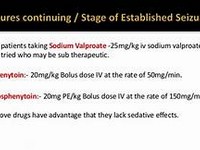Fosphenytoin sodium
CLINICAL USE
Control of status epilepticus Seizures associated with neurosurgery or head injury when oral phenytoin is not possible
DOSE IN NORMAL RENAL FUNCTION
Status epilepticus: Treatment: 20 mg PE/kg (loading dose) —by
IV infusion
Maintenance: 4–5 mg PE/kg daily in —1–2 divided dosesProphylaxis or treatment of seizures: 10– 15 mg PE/kg by
IV infusion
; then convert to phenytoin or 4–5 mg PE/kg daily in 1–2 divided doses
PHARMACOKINETICS
DOSE IN RENAL IMPAIRMENT
GFR (mL/MIN)
DOSE IN PATIENTS UNDERGOING RENAL REPLACEMENT THERAPIES
IMPORTANT DRUG INTERACTIONS
Potentially hazardous interactions with other drugs
ADMINISTRATION
Reconstition
–
Route
IV, IM
Rate of Administration
Status epilepticus : 100–150 mg PE/min Treatment and prophylaxis of seizures: 50–100 mg PE/min
Comments
Dilute further when using for
IV infusion
with sodium chloride 0.9% or glucose 5% to 1.5–25 mg PE/mL
OTHER INFORMATION
75 mg of fosphenytoin sodium is equivalent to 50 mg of phenytoin0.037 mmol of phosphate/mg of fosphenytoinDecreased protein binding in renal failure Monitor ECG, BP and respiratory function during infusionWhen substituting IV, IM use same dose and frequency as for oral phenytoin, administer at a rate of 50–100 mg PE/minMay increase blood glucose in diabetic patientsSome is dialysed out, as not all PE is protein-boundHalf-life of fosphenytoin to phenytoin is 15 minutes; more rapid in renal failure due to reduced protein binding.
